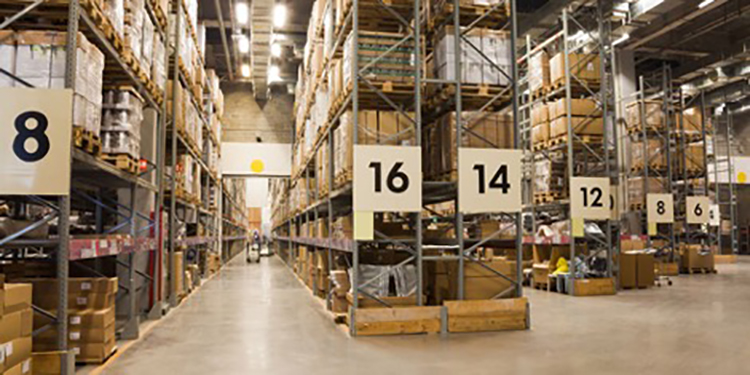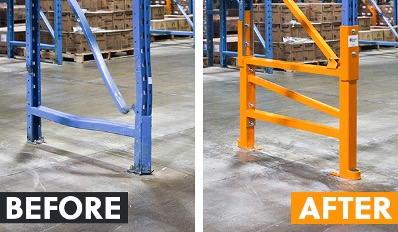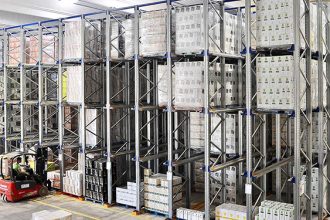Key Elements Of An Effective Warehouse Rack Safety Program

According to the National Safety Council (NSC), in 2021 workers in warehousing and transportation experienced the highest injury rate involving days away from work. To reduce those numbers and keep their employees safer on the job, many companies are continuously improving their safety practices. It’s important to include industrial steel storage rack as part of those safety measures. To be effective, the ideal warehouse rack safety plan includes several key elements to minimize the risks of accidents and injuries.
“For warehouse managers, safety is paramount for their employees and visitors, as well as for products and equipment,” explained Charles Carbonneau, Chief Engineer at Damotech. The company is a member of the Rack Manufacturers Institute (RMI).
“Neglecting rack safety can lead to severe consequences. These include injuries, property damage, and operational disruptions,” he continued. “Other downsides include inventory damage and loss, downtime, operational inefficiencies, and reputational damage for the company.”
Benefits of a Rack Safety Program

A well thought out rack safety program can positively impact the bottom line by preventing accidents and reducing costs. While the specific elements of a rack safety program will be unique to each operation, Carbonneau noted that the most comprehensive programs include several commonalities. They include:
- A focus on training and protecting employees.
- Measures to reduce rack damage and subsequent downtime.
- Compliance with government regulations and industry standards.
“Ultimately, by prioritizing rack safety a company will positively impact its bottom line by establishing a secure, efficient warehouse environment that protects employees, equipment, and products,” Carbonneau added.
Improve Rack Safety with These Four Elements
A comprehensive rack safety program consists of four key elements that should be practiced routinely.
“A rack safety program is an ongoing process without a definitive start or end,” said Carbonneau. “Continuous effort is essential to ensure a safe warehouse environment.”
Rack Inspections
There are, in fact, six different types of inspections that should be performed throughout a pallet rack’s lifespan. The first four — at the point of manufacture, upon delivery to the installation site, during installation, and post-installation to satisfy permitting requirements — happen before the rack is in use.
Once commissioned, however, periodic rack inspections should occur. These can be performed by warehouse employees, third-party rack specialists, or a combination of the two. Frequency of inspections typically correlates to frequency of use, volume of traffic, load weights, and other usage factors.
 “Best practice is for warehouse staff to perform routine visual inspections at least monthly. They should be looking for damage, loose connections, beams or columns that are twisted or out-of-plumb, sheared or missing anchor bolts, and any other indication that the rack has sustained an impact,” Carbonneau advised.
“Best practice is for warehouse staff to perform routine visual inspections at least monthly. They should be looking for damage, loose connections, beams or columns that are twisted or out-of-plumb, sheared or missing anchor bolts, and any other indication that the rack has sustained an impact,” Carbonneau advised.
“It’s also a best practice to bring in a third-party rack engineer to perform a compliance inspection annually,” he continued. “These are more detailed assessments that verify that the rack structure matches the load application and rack configuration (LARC) drawings, as well as adheres to industry standards.”
Inspection and Engineering Reports
Documentation of inspections, when they occurred, any damage noted, and remediation measures is another critical element of a rack safety program. Carbonneau explained that annual compliance inspections should result in a formal engineering report.
“Engineering reports provide technical insights, including repair recommendations and prioritization of corrective actions,” he said.
Additionally, operations can leverage rack inspection and maintenance software programs to help with tracking inspections and their findings. “These software tools help to identify patterns, such as areas or zones of rack that are damaged more frequently. Further, using rack maintenance software converts insights into actionable steps, facilitates progress monitoring, and tracks safety improvements.”
Routine Maintenance and Repair
Like all equipment used in a warehouse, pallet rack needs routine maintenance. Identifying and alerting management to rack damage immediately upon discovery, even something that appears minor, is a critical part of a rack safety program.
“The sooner an issue is identified — whether it’s a loose beam or a connector clip or bolt discovered on the floor — the faster it can be addressed,” Carbonneau observed. “Replacing components or repairing damage will reduce the risk of accidents and injuries. It will also minimize maintenance expenses and prolong the rack’s lifespan.”
 In some instances, a damaged rack upright or cross brace can be repaired. An evaluation by a qualified, professional rack engineer will determine if the components require replacement or if an engineered rack repair kit will suffice. These kits, sourced from the original rack manufacturer or a qualified third party, can restore load capacity while saving costs and time, said Carbonneau.
In some instances, a damaged rack upright or cross brace can be repaired. An evaluation by a qualified, professional rack engineer will determine if the components require replacement or if an engineered rack repair kit will suffice. These kits, sourced from the original rack manufacturer or a qualified third party, can restore load capacity while saving costs and time, said Carbonneau.
“When properly designed and secured, rack repair kits minimize disruptions to warehouse operations and safeguard the system’s structural integrity,” he noted. “They also reduce steel waste and extend the useful life of the rack.”
Safety Training
 Employee training and education is another key element of a rack safety program. All personnel should be trained to recognize rack damage or unsafe situations and report their observations to their supervisors. Forklift operators should understand how to properly load and unload pallet rack so beams are not dislodged and loads do not fall. They should also be trained to not hit racks with their vehicle, its forks, or the load it carries.
Employee training and education is another key element of a rack safety program. All personnel should be trained to recognize rack damage or unsafe situations and report their observations to their supervisors. Forklift operators should understand how to properly load and unload pallet rack so beams are not dislodged and loads do not fall. They should also be trained to not hit racks with their vehicle, its forks, or the load it carries.
All personnel should understand the importance of the information contained on load capacity plaques. Further, all employees should never climb into the rack structure for any reason. There are several safer ways to retrieve fallen items or resolve jams in high-density systems such as pushback or pallet flow rack.
Need Help Creating an Effective Rack Safety Program?
Developing, implementing, and maintaining a successful rack safety program can be challenging, acknowledged Carbonneau. It involves assessing hazards, implementing safety measures, and staying up to date on current regulations. Fortunately, help is available.
“Engage the members of RMI for help in launching and continuously improving a rack safety program,” he advised. “The organization can provide access to experienced warehouse safety experts. They can share their engineering expertise to identify overlooked hazards, offer an unbiased perspective on a given operation, provide ongoing support, and ensure regulatory compliance.
Additionally, RMI offers multiple resources detailing ways to improve pallet rack safety and protect employees and assets. This includes presentations, publications, case studies, frequently asked questions, and an MHI Cast podcast. For more information, visit mhi.org/rmi.


